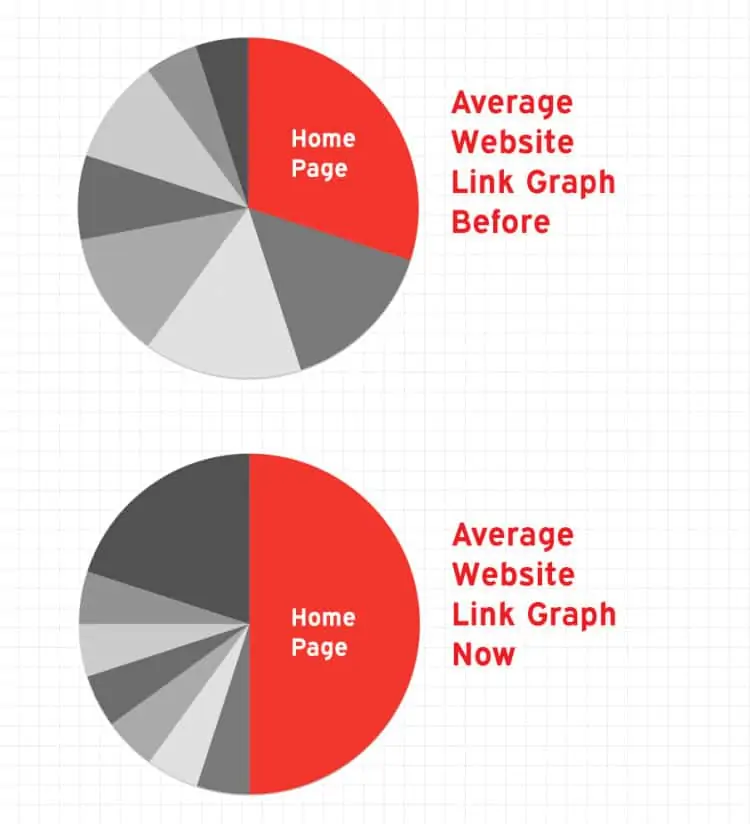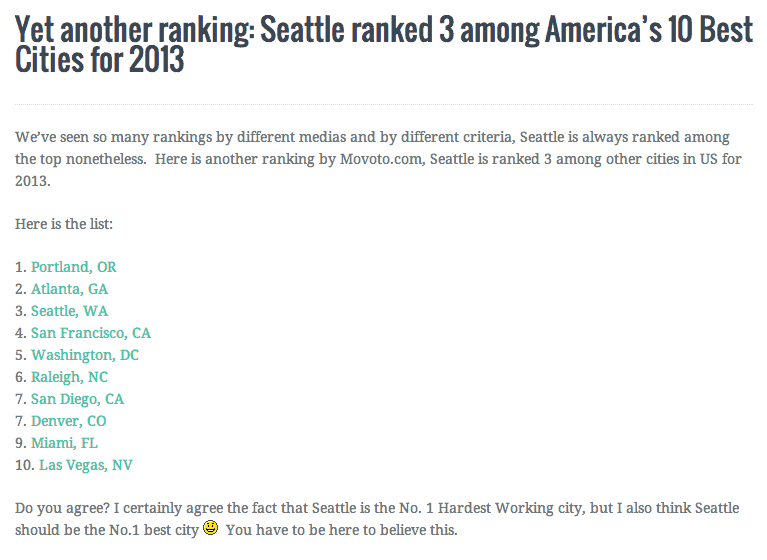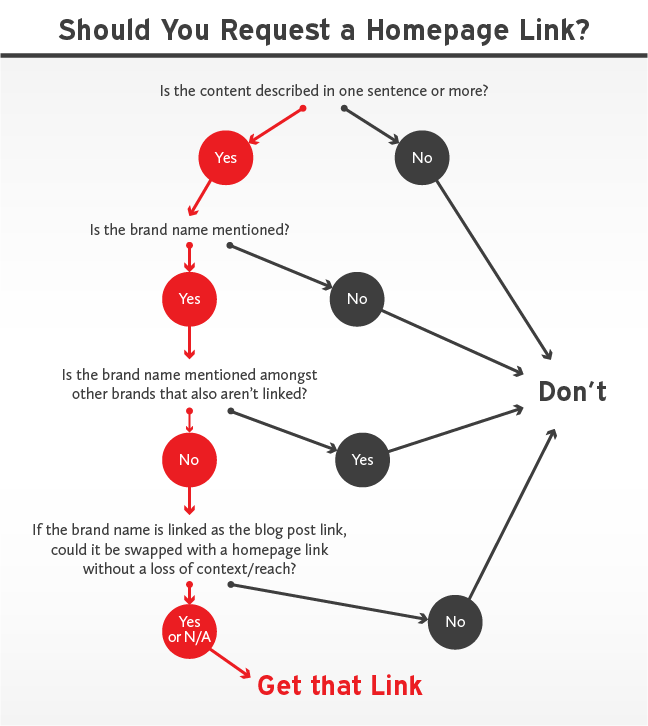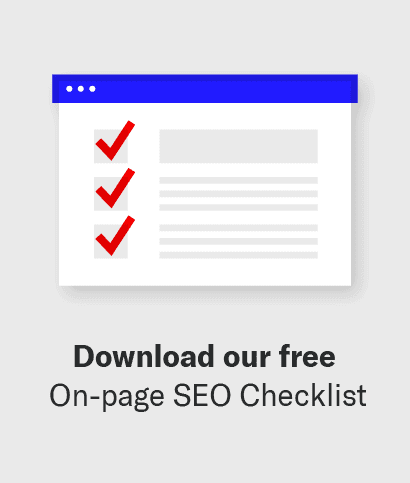We frequently get the comment from clients that they don’t want “blog links”. This means that many businesses are on to the content marketing game, but they understand that they still need links to their “money” pages in order to rank well – that is, the commercial landing pages that are increasingly difficult to build natural, sustainable links into.
It is very possible to build links into money pages with content you host on the blog – if you do it right. However, you definitely can place content on the blog and never get links back to your money pages. In that situation, the activity won’t be as prosperous for search unless it absolutely knocks it out of the park from a branding/secondary KPI perspective.
Readjusting to the Status Quo
Although building links into secondary money pages is still possible, it’s difficult. In today’s world the page balance of 30% homepage and 10% across secondary landing pages just isn’t likely, because that was only made possible by some paid junk we funneled in there to get some commercial anchor text.
In a more realistic environment, page balance leans towards the homepage more heavily, where it’s most natural for people to link to the businesses they like. Rarely will the common user think to reference some longtail category page in a natural way – and for that reason, our ratios should reflect this.
So, the first part of this reshuffling is to accept the fact that subpage “money” links will simply not be as prolific as they have been in the past. The core weight of many sites’ linking profile will most likely sit at its homepage, or at least significantly more so than it had five years ago, because this is the most naturally occurring activity.
If we accept this and adjust to it, we can build even more links to the homepage and use site architecture to funnel the authority in a way that’s now necessary in order to sustain those other pages. However, we should still not completely abandon the effort of bringing equity into the subpages, as the reward of doing so is now greater than it had ever been in the past.
Strong Internal Linking = Linked Quotes
When we create blog content for clients and link internally to one or more landing pages in a way that adds value to the post, we find that around 10-15% of the time publications that pick it up will retain an additional internal link in their story. This is even more likely when we can pair a nice linking opportunity with a solid quote.
When pulled out, the probability of the internal link being retained is much higher, because, of course, it’s more likely to be paired with something the writer wants to use as a point of emphasis for their story. If we bury it at the end of the story or in a part that probably won’t add value, it’ll likely do little other than live as additional internal linking fodder for a spider to crawl.
For example, check out this story that covered popular real estate site Movoto. In it, the writer copy and pasted Movoto’s top ten ranking, and in doing so also linked to ten of Movoto’s money pages. Not a bad score, right? And it was all made possible by Movoto giving reporters something very simple to grab that added context to the story that many reporters might want to utilize.
Similarly, if your commercial landing page is a complementary part of that piece of content (which, if done well, it almost always should be), the writer is much more likely to link to it in their story – and/or link to it in a subsequent request by you.
Build Content Adequately Described Offsite
A second element that can generate homepage links for you is the philosophy of building content that can be adequately described offsite. In this kind of situation, writers are more likely to link to your homepage as a brand reference rather than the source of the hosted content, because the source of the hosted content does not add much more value than what is being described in their article.
Situations that best describe this are with visualizations or infographics. Although given a bad name, they are the most obvious example of content that can be fully described on another blog without ever needing a mention back to the original blog post – because the most valuable part of the content can be posted in full.
For this reason, homepage mentions will frequently happen organically when they are referenced. Also, these kinds of situations offer the opportunity to follow-up and request a link swap from the blog post to the homepage.
Other examples of this is content hosted on other sites, such as Facebook, Twitter, or perhaps a press release or story you never hosted on-site. Sometimes it’s possible (or required) to seed content to reporters that never lives on your domain, which can sometimes work to your advantage if it means a higher probability of a homepage mention versus a page buried on a press room hosted on a subdomain.
Have a Brand that Adds Context by Being Mentioned
Another no-brainer: become a well-known brand and the chances are you’ll improve your probability of getting homepage links. You’re more likely to be referenced as a way to add context to the article for readers rather than a bland description of just the article itself. Your homepage will likely be linked to more often, and thereby, the rich (brands) will get even richer.
Following Up With a Homepage Link Request
Requesting a homepage link after the fact, where applicable, is another necessary part of the process to improve the probability of getting links that pass greater SEO value versus only the blog link. Generally, we’ll look at what the initial coverage looks like and then assess what kind of link request is possible, if any.
The thought process generally follows this internal questioning assessment, which is based on how awkward or forced the asked is, and whether or not you’d burn a relationship by asking for a link to the homepage.
- Is the content described in one sentence or less? No request. [Example]
- Is the brand name never mentioned? No request. [Example]
- Is the brand name mentioned along many other brands and none of them are linked? No request. [Example]
- If the brand name is linked as a blog post link, could it be swapped with the homepage link without a loss in context/visibility potential? Request. [Example That Couldn’t. Example That Could.]
For more visual learners, and to provide a resource for this process, we’ve constructed the following handy flowchart for your decision tree on whether or not to request a homepage link. Every decision is a little bit different, but this guide should generally inform your thought process.
The second stage of this process is to assess how big of a request to make. A homepage link is one thing, but, where it makes sense, it’s also possible to get commercial landing page links. This depends on the context of the conversation, the article, and the congruity with your piece.
- Was the article posted without the writer ever corresponding with you? Homepage request.
- Was the article posted with several back-and-forths with the writer such that rapport was built? Does the commercial page make sense to be mentioned? Commercial page request.
Generally the rapport established through correspondence (or possibly multiple articles having been covered from you) enables you to make a bigger ask to get a subpage linked to rather than the homepage. If you’re adding significant value to that writer, most will not have an issue linking to a subpage, as long as it really does make sense to add to the article.
In general, a good philosophy for a link request is to limit asks for a single change to their post that will also add value to readers. If your ask involves multiple changes or a change to the way their normal editorial standards operate, you will burn a bridge, look bad and likely get shot down. Not worth it – be happy with the initial coverage.
A Template for the Second Request
Second requests generally require a lot more customization than a normal outreach template, simply because it feels more natural to be conversational rather than adhere to a standard format. Despite that, a general template as a starting point is always helpful to save time. Here is our suggested blueprint for following up with a second request:
Hey NAME,
Thanks so much for covering our recent article. QUICK CUSTOM RESPONSE TO COVERAGE.
Anyway, I’m reaching out today with a small request – is it possible to link to our homepage, http://WEBSITE.com where you mention BRANDNAME on the post? I think it would add additional value/context to your readers, and of course, would be much appreciated as well.
Thanks so much for considering and if nothing else, consider this email a thanks!
Cheers,
NAME
This template is meant to be transparent but also honest – if this is a good request, your link really does add context to their readership. If it’s a bad request, it does not add context and you’re probably going to strike out. It’s also necessary to add some good commentary about their coverage, because, of course, they probably put a lot of work into it and they deserve that kind of respect back.
Rarely, if ever, does this template fail, when applied against the above flow chart. The only rare situation is when it’s company policy only to link in a certain way, in which case it was a failed mission going in.
Good Content is Good Content, Anywhere
Yes, we’d all like the best content of all time to be our product rather than supplementary material hosted on a blog. But good content is good content, and if it can be produced, you shouldn’t care much about where it’s hosted, especially if your team is aware enough to follow up on opportunities available to them like what’s mentioned in this post.
At the end of the day, you should still be happy about blog links, but you should be happier still about blog links you can transition into more valuable links to the pages that make the biggest difference in your visibility through search.








